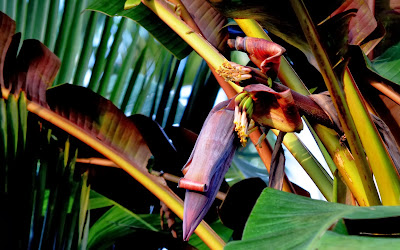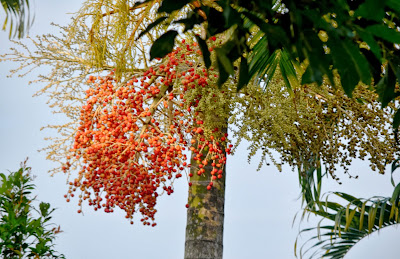 |
| View of front garden |
 |
Holskioldia sanguinea
Chinese hat plant |
The Kambatik garden is shaping up. The garden's emphasis on a perpetual summer and autumn is felt in the garden colours from fruits, flowers, leaves and stem or tree trunks. Living in a hot and humid tropics like Kuching one just need to be a bit more imaginative to provide the intermittent flushing of leaves, the permanent variegation of leaves and bracts to make the garden a riot of colours. The Chinese hat plant can be trained as a climber to give the everyday presence of orange to red colours in the enlarged calyx of its inflorescence. The garden remains cool in the afternoon because of shade provided by the trees. Many tall shrubs like the mussaendas and hibiscus have variegated leaves just like many perennial herb species of the croton, cordyline and gingers. Thus the choice of spring to summer to autumn colours are a plenty and can range the full colours of the spectrum. Besides tress providing shade a reasonable sized lawn is important to throw down the shade on the garden floor, providing recreational space,scale, and access to the garden borders, corners and also as a flight corridor for butterflies.
 |
Frontal view of garden, seen from the road.
Note the red fruits of the Carpentaria palm and the orange to red flushes of the Eugenia oleina in the background. |
I have not seen the Mango tree flowering very heavily like this time around. It is my fervent hope that the tree will bear as many fruits as possible in the weeks ahead. Part of the concept of the Kambatik garden is edible landscaping or in Malay is referred to as 'sara landskap'. In the traditional Malay homes, the back garden is mainly planted with edible fruits, vegetables, herbs with medicinal value and a host of smaller trees,shrubs or covers for its salad value as well.
 |
| Pagoda flower (Clerodendrum paniculatum) |
 |
| Cassia alata |
 |
| Senduduk (Malay) - Melastoma malabathricum |
 |
| White costus (Costus speciosus) |
 |
| Coconut leaves |
I am glad that the Kuching garden is giving us much pleasure as well as responsibility in the advancement of ecological diversity, wildlife and more clean oxygen to the living space around us. Life seems justified in leaving behind a greener planet and more prosperity for wildlife alongside the human species.








































































.jpg)


